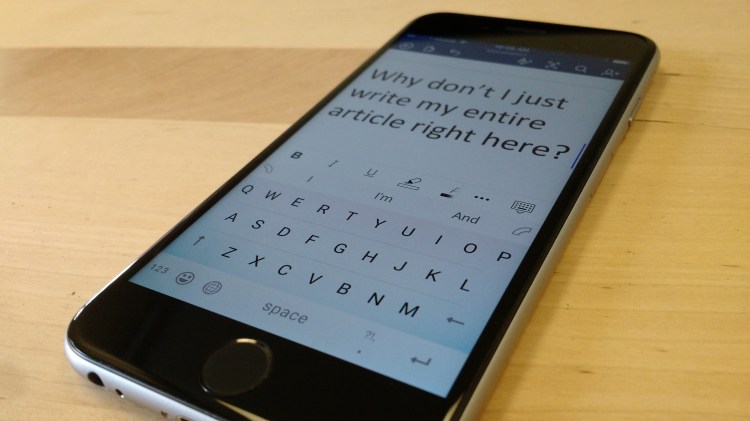Microsoft has finally released its Word Flow keyboard — a native feature of the Windows Phone — on the App Store for iOS devices. I’ve been playing around with the keyboard on an iPhone 6s, and I’ve got to say, it’s an excellent addition to the phone.
The most important feature of the keyboard is the ability to swipe across multiple keys with a finger in order to type in words. For those who are used to Apple’s standard keyboard on the iPhone and the iPad, swiping will be a revelation in itself. (This is also a core part of Google’s standard Android keyboard, which is also reported to be coming to iOS.)
When you swipe, the keyboard makes a prediction about the word you’re trying to enter. Some keyboards are more accurate than others in their predictions. For example, I’ve been disappointed by the ones from SwiftKey, which incidentally Microsoft acquired a few months ago, and Escargot Studios’ Brilliant Keyboard. With Word Flow, the predictions are not quite as good as the ones on Google’s Android keyboard, but they’re almost as good. So you don’t always have to hit backspace on a word and enter it again, by swiping or pecking.
The keyboard sits horizontally across the bottom of the display, in both portrait and landscape modes. When you’re in portrait mode, you have the keyboard nest itself comfortably in the bottom left or right corner. Beyond just looking cool, this setup lets you type easily by swiping with just one finger on one hand — most likely your thumb. I’m not used to this configuration, and I find myself making many mistakes as a result. But if I were to take the time to get used to it, I bet I could get pretty fast at typing with it.
When you swipe your finger across the keyboard, a bluish glow and a few blue dots follow the movement. Nothing like this ships with the Google keyboard. Is it helpful? Not particularly.
There are several themes to choose from for the look of the keyboard, including a dark theme, and you can even use one of your own photos for the background, and then select the color for the letters on the keyboard. You can tell the keyboard to learn your words, forget your words, autocorrect words, predict contacts, make sounds, automatically capitalize, and double-tap the spacebar for a period.
Of course, this is not the first app Microsoft has made for iOS devices. The Office apps, Outlook, Cortana, Microsoft Translator, and other apps are already there on the Apple mobile platform. And earlier this month the Hub keyboard became available on iOS, courtesy of the Microsoft Garage.
The question is if Apple will develop its own swipe-friendly keyboard as a default component of iOS 10 — because otherwise, keyboards like this one and Google’s could very well become the standard on Apple’s mobile devices.
VentureBeat's mission is to be a digital town square for technical decision-makers to gain knowledge about transformative enterprise technology and transact. Learn More

